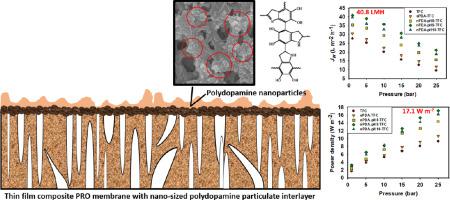Desalination ( IF 8.3 ) Pub Date : 2021-07-06 , DOI: 10.1016/j.desal.2021.115222 Ralph Rolly Gonzales 1, 2 , Lei Zhang 3, 4 , Kecheng Guan 2 , Myoung Jun Park 1 , Sherub Phuntsho 1 , Ahmed Abdel-Wahab 5 , Hideto Matsuyama 2, 3 , Ho Kyong Shon 1

|
Polydopamine (PDA), formed from self-polymerization of dopamine, was coated on aliphatic polyketone membrane substrate prior to interfacial polymerization (IP), preparing a pressure retarded osmosis (PRO) thin film composite (TFC) membrane with a PDA interlayer. The effect of the formation of two types of PDA interlayers — smooth and particulate — on substrate morphology, polyamide formation, and PRO osmotic performance were investigated. Also, the effect of pH on the particulate PDA interlayer was studied. It was found that the introduction of both smooth and particulate PDA contributes to enhanced water flux and power density of the PRO membranes. pH was found to have significantly affected the formation of particulate PDA and the polyamide formation, as well. At higher pH, PDA self-polymerization led to the formation of more nanoparticles, the subsequent increase in surface roughness and decline in the polyketone substrate porosity. The particulate PDA interlayer formed looser polyamide, compared to the thinner and denser polyamide formed on pristine and smooth PDA-interlayer-coated TFC membranes. The membrane performance was evaluated using deionized water and 1.0 M NaCl as feed and draw solutions, respectively. The TFC membrane with nanoparticulate PDA layer formed at pH 9.0 exhibited the best initial water flux of 40.8 L m−2 h−1, and this membrane also showed the highest power density of 17.1 W m−2 at 25 bar. The results of this study indicate that nanoparticulate PDA interlayer formation is a simple and scalable TFC membrane development method for engineered osmosis.
中文翻译:

具有受贻贝启发的聚多巴胺中间层的脂肪族聚酮基薄膜复合膜用于高性能渗透发电
由多巴胺自聚合形成的聚多巴胺(PDA)在界面聚合(IP)之前涂覆在脂肪族聚酮膜基材上,制备具有PDA夹层的压力延迟渗透(PRO)薄膜复合(TFC)膜。研究了两种类型的 PDA 夹层(光滑和颗粒)的形成对基材形态、聚酰胺形成和 PRO 渗透性能的影响。此外,还研究了 pH 值对颗粒状 PDA 夹层的影响。发现光滑和颗粒状 PDA 的引入有助于提高 PRO 膜的水通量和功率密度。发现 pH 值也显着影响颗粒状 PDA 的形成和聚酰胺的形成。在较高的 pH 值下,PDA 自聚合导致形成更多的纳米粒子,随后表面粗糙度的增加和聚酮基材孔隙率的下降。与在原始光滑的 PDA 夹层涂层 TFC 膜上形成的更薄更密的聚酰胺相比,颗粒状 PDA 夹层形成的聚酰胺更松散。分别使用去离子水和 1.0 M NaCl 作为进料和汲取溶液来评估膜性能。在 pH 9.0 下形成的具有纳米颗粒 PDA 层的 TFC 膜表现出最佳的初始水通量为 40.8 L m 分别。在 pH 9.0 下形成的具有纳米颗粒 PDA 层的 TFC 膜表现出最佳的初始水通量为 40.8 L m 分别。在 pH 9.0 下形成的具有纳米颗粒 PDA 层的 TFC 膜表现出最佳的初始水通量为 40.8 L m-2 h -1,并且该膜在25巴下也显示出17.1 W m -2的最高功率密度。这项研究的结果表明,纳米颗粒 PDA 夹层的形成是一种用于工程渗透的简单且可扩展的 TFC 膜开发方法。











































 京公网安备 11010802027423号
京公网安备 11010802027423号